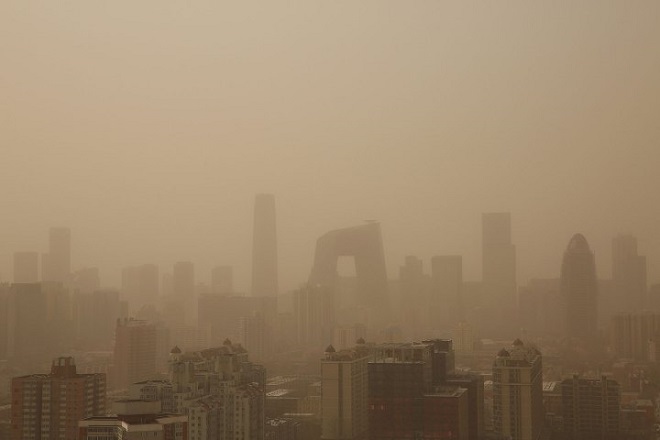Spring Sandstorms Add to China's Bad Air Misery

A general view of the skyscrapers in the sandstorm on Feb. 28, 2013 in Beijing, China
Beijing, a city already notorious for its smog, has seen some of the worst air quality in memory over the first weeks of 2013. Much of the blame has rightly been aimed at coal burning, the rising number of vehicles, the low quality of fuel standards and industrial pollution that blows in from surrounding regions. But this week the Chinese capital has been hit with an air quality disaster of a more ancient vintage: a sandstorm blowing out of the north.
On Wednesday afternoon I sat in an office building on the city’s east side and could see across the city of some 20 million to the Fragrant Hills to the west, the sort of clarity that only happens a few times a year. Then, within the space of an hour, visibility was back to the Beijing standard of a few blocks. On Wednesday morning the concentration of particles smaller than 10 micrometers in diameter soared briefly on the city’s west side to nearly 1,000 micrograms per cubic meter. By comparison, the World Health Organization guideline for 24-hour mean levels of PM 10 is 50 micrograms. The city’s Environmental Protection Bureau advised residents to stay inside if possible.
The sandstorm hit Beijing just as the city was preparing for the annual National People’s Congress. Yao Ming, who is in town as a delegate to the Chinese People’s Political Consultative Conference, an advisory body that meets ahead of the NPC, was photographed grimacing at the sky as he left his hotel this morning. The government will undoubtedly face new calls for a solution to China’s air pollution woes as the NPC meets next week. The issue, which has long been downplayed, has simmered online recently as Chinese microblog users have posted air pollution data online, first from a meter run by the U.S. Embassy that measures finer, more dangerous PM 2.5 particles, and now from the local environmental protection bureaus in Beijing and other cities that have begun posting detailed PM 2.5 readings.
For much of the winter the winds blowing from the north have offered a rare respite from pollution, as cold air from less polluted Mongolia has flushed out the toxic haze in the Chinese capital. But as spring comes, snow and ice melt leaving vast stretches of desert and dry, sandy earth exposed. Then the wind brings a stinging grit, and a reminder that as China tries to clean up the pollution caused by untrammeled development, it also struggles to contain the mess it has faced for centuries.
You can return to the main Market News page, or press the Back button on your browser.

